The NVIDIA GeForce GTX 980 Ti Review
by Ryan Smith on May 31, 2015 6:00 PM ESTPower, Temperature, & Noise
As always, last but not least is our look at power, temperature, and noise. Next to price and performance of course, these are some of the most important aspects of a GPU, due in large part to the impact of noise. All things considered, a loud card is undesirable unless there’s a sufficiently good reason – or sufficiently good performance – to ignore the noise.
As the GM200 flagship card, GTX Titan X gets the pick of the litter as far as GM200 GPUs go. GTX Titan X needed fully-functional GM200 GPUs, and even then needed GPUs that were good enough to meet NVIDIA’s power requirements. GTX 980 Ti on the other hand, as a cut-down/salvage card, gets second pick. So we expect to see these chips be just a bit worse; to have either functional units that came out of the fab damaged, or have functional units that have been turned off due to power reasons.
| GeForce GTX Titan X/980 Voltages | ||||
| GTX Titan X Boost Voltage | GTX 980 Ti Boost Voltage | GTX 980 Boost Voltage | ||
| 1.162v | 1.187v | 1.225v | ||
Looking at voltages, we can see just that in our samples. GTX 980 Ti has a slightly higher boost voltage – 1.187v – than our GTX Titan X. NVIDIA sometimes bins their second-tier cards for lower voltage, but this isn’t something we’re seeing here. Nor is there necessarily a need to bin in such a manner since the 250W TDP is unchanged from GTX Titan X.
| GeForce GTX 980 Ti Average Clockspeeds | |||
| Game | GTX 980 Ti | GTX Titan X | |
| Max Boost Clock | 1202MHz | 1215MHz | |
| Battlefield 4 |
1139MHz
|
1088MHz
|
|
| Crysis 3 |
1177MHz
|
1113MHz
|
|
| Mordor |
1151MHz
|
1126MHz
|
|
| Civilization: BE |
1101MHz
|
1088MHz
|
|
| Dragon Age |
1189MHz
|
1189MHz
|
|
| Talos Principle |
1177MHz
|
1126MHz
|
|
| Far Cry 4 |
1139MHz
|
1101MHz
|
|
| Total War: Attila |
1139MHz
|
1088MHz
|
|
| GRID Autosport |
1164MHz
|
1151MHz
|
|
| Grand Theft Auto V |
1189MHz
|
1189MHz
|
|
The far more interesting story here is GTX 980 Ti’s clockspeeds. As we have pointed out time and time again, GTX 980 Ti’s gaming performance trails GTX Titan X by just a few percent, this despite the fact that GTX 980 Ti is down by 2 SMMs and is clocked identically. On paper there is a 9% performance difference that in the real world we’re not seeing. So what’s going on?
The answer to that is that what GTX 980 Ti lacks in SMMs it’s making up in clockspeeds. The card’s average clockspeeds are frequently two or more bins ahead of GTX Titan X, topping out at a 64MHz advantage under Crysis 3. All of this comes despite the fact that GTX 980 Ti has a lower maximum boost clock than GTX Titan X, topping out one bin lower at 1202MHz to GTX Titan X’s 1215MHz.
Ultimately the higher clockspeeds are a result of the increased power and thermal headroom the GTX 980 Ti picks up from halving the number of VRAM chips along with disabling two SMMs. With those components no longer consuming power or generating heat, and yet the TDP staying at 250W, GTX 980 Ti can spend its power savings to boost just a bit higher. This in turn compresses the performance gap between the two cards (despite what the specs say), which coupled with the fact that performance doesn't scale lineraly with SMM count or clockspeed (you rarely lose the full theoretical performance amount when shedding frequency or functional units) leads to the GTX 980 Ti trailing the GTX Titan X by an average of just 3%.
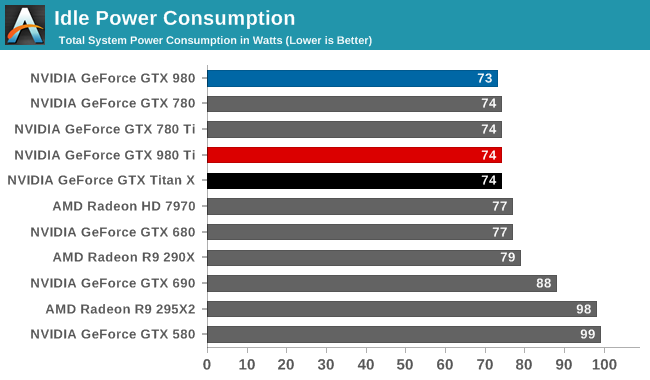
Starting off with idle power consumption, there's nothing new to report here. GTX 980 Ti performs just like the GTX Titan X, which at 74W is second only to the GTX 980 by a single watt.
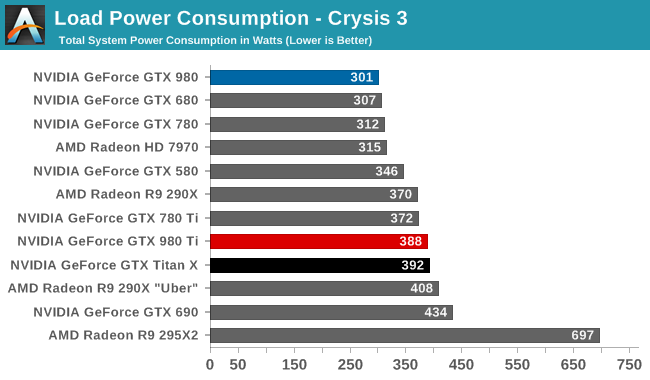
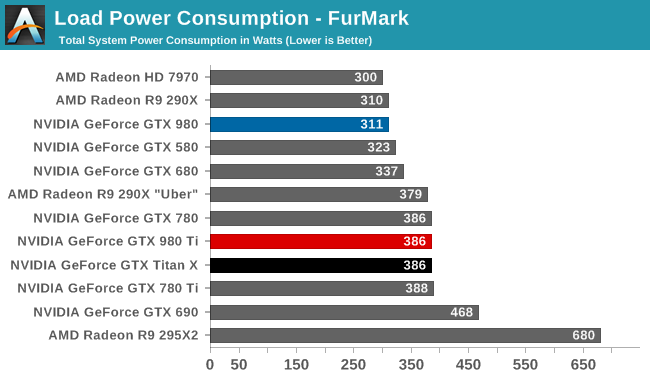
Meanwhile load power consumption is also practically identical to the GTX Titan X. With the same GPU on the same board operating at the same TDP, GTX 980 Ti ends up right where we expect it, next to GTX Titan X. GTX Titan X did very well as far as energy efficiency is concerned – setting a new bar for 250W cards – and GTX 980 Ti in turn does just as well.
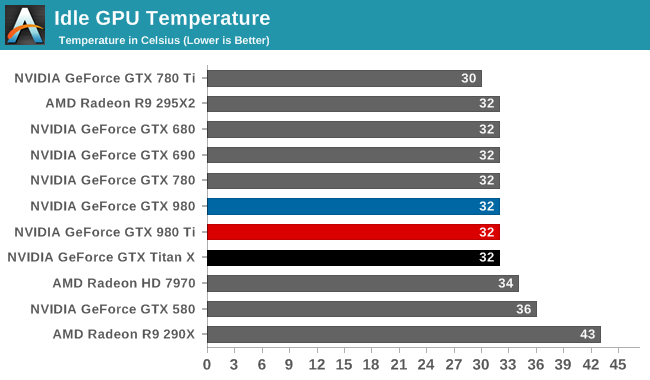
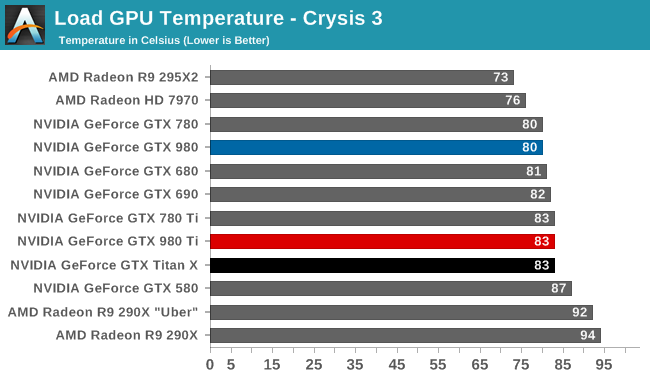
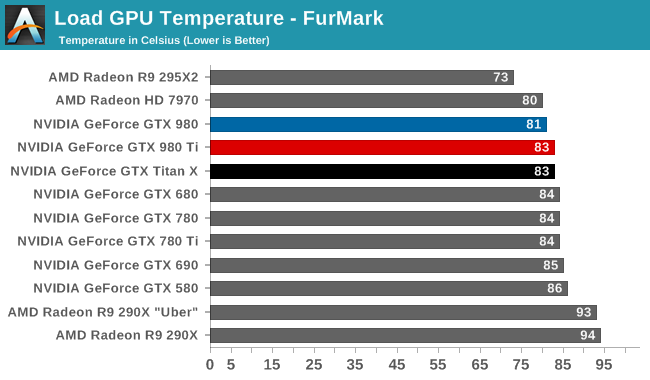
As was the case with power consumption, video card temperatures are similarly unchanged. NVIDIA’s metal cooler does a great job here, keeping temperatures low at idle while NVIDIA’s GPU Boost mechanism keeps temperatures from exceeding 83C under full load.
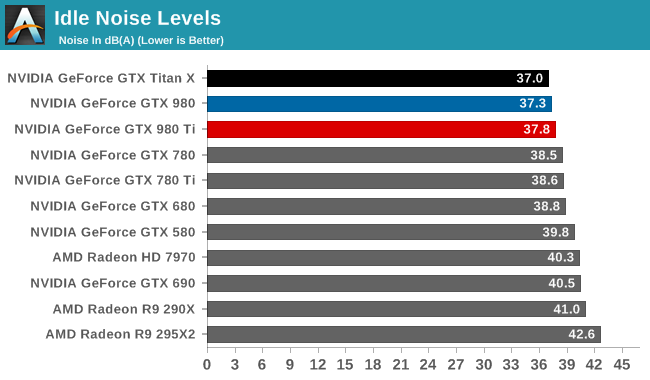
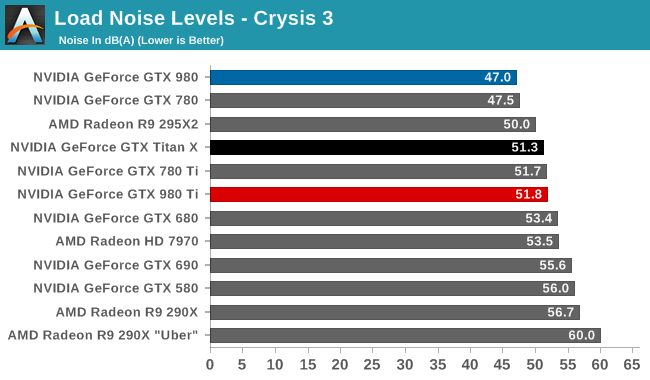
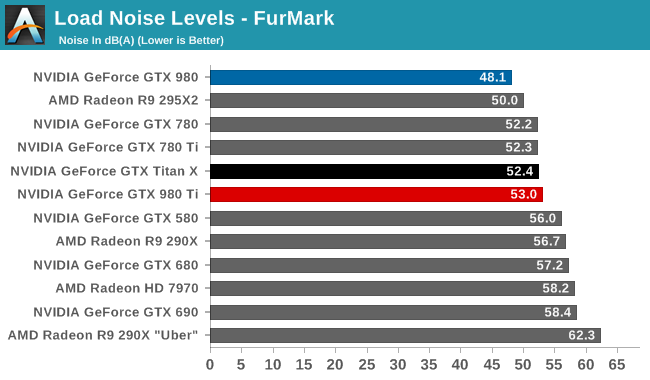
Finally for noise, the situation is much the same. Unexpected but not all that surprising, the GTX 980 Ti ends up doing a hair worse than the GTX Titan X here. NVIDIA has not changed the fan curves or TDP, so this ultimately comes down to manufacturing variability in NVIDIA’s metal cooler, with our GTX 980 Ti faring ever so slightly worse than the Titan. Which is to say that it's still right at the sweet spot for noise versus power consumption, dissipating 250W at no more than 53dB, and once again proving the mettle of NVIDIA's metal cooler.










290 Comments
View All Comments
PEJUman - Monday, June 1, 2015 - link
I agree, the fact that AMD new 3xx is mostly (sans 1 new GPU) rebrands scares the crap out of me. and Nvidia knows it too, that's why we're getting the bad witcher 3 on gameworks @ kepler, astronomical prices and a generally very 'apple like marketing' from nvidia.Don't get me wrong, I certainly appreciate the level of refinements that Nvidia brings to the table, but without any answer from AMD, prices are very far from reasonable.
few years ago, I would never guessed PC gaming will be dead due to single GPU supplier situation, nowadays I am a lot more unsure...
Yojimbo - Monday, June 1, 2015 - link
In that case why assume that the 980 should have been dropped in price more. Maybe the 980 Ti should have been priced at $700?The difference between $500 and $650 is palpable. And the performance one requires depends on the monitor one has. What you seem to be saying is you would be willing to pay more than 30% price premium for a 30% increase in performance, which is usual. But when prices are actually set that way, there always seem to be people complaining the premium card is priced too high, and quoting the price/performance difference as the reason.
chizow - Monday, June 1, 2015 - link
@Yojimbo lol so true, people seem to think price:perf should be perfectly linear and comparable to some bargain bin part at $75, but if that was always the case, we'd all be using 2-3 gen old cards that can't play the games we want to play, today.dragonsqrrl - Sunday, May 31, 2015 - link
The 980 is $550, not $499. Despite that it still has a similar price/performance ratio to the 980 Ti. So technically it's no worse of a deal than the 980 Ti, but I think the 980 should still drop in price to ~$500 or $450. It should have a better price/performance ratio than the higher-end Ti.jjj - Sunday, May 31, 2015 - link
The 980 price has been dropped to 499$ and the point was that the TI and the 970 are much better buys, the 870 being way cheaper for little perf loss while the TI offers a lot more perf and is far better at 4k.dragonsqrrl - Sunday, May 31, 2015 - link
Ahh, sorry I missed that. However, at $500 the 980 still has a similar price/performance ratio as the 980 Ti. So while I do think it should drop by more, I'm also a bit confused by why people are calling it a terrible buy when it really isn't anymore terrible than the Ti at $650.just4U - Sunday, May 31, 2015 - link
(...sigh) $740 here in Canada.dragonsqrrl - Sunday, May 31, 2015 - link
:(o-k - Sunday, May 31, 2015 - link
could you please make sure this time that the ram is 384-Bit, 6GB total @ 7GHz GDDR5. Please double check.D. Lister - Sunday, May 31, 2015 - link
No, drop everything in your life AT staff, and effing TRIPLE check, and make sure to provide a notarized video of the process. Anything, ANYTHING at all, that can wash away the salt of the AMD rebadge, C'MOOOOON!